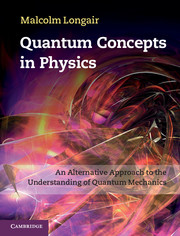Book contents
- Frontmatter
- Contents
- Preface
- Acknowledgements
- Part I The Discovery of Quanta
- Part II The Old Quantum Theory
- Part III The Discovery of Quantum Mechanics
- 10 The collapse of the old quantum theory and the seeds of its regeneration
- 11 The Heisenberg breakthrough
- 12 Matrix mechanics
- 13 Dirac's quantum mechanics
- 14 Schrödinger and wave mechanics
- 15 Reconcilingmatrix and wave mechanics
- 16 Spin and quantum statistics
- 17 The interpretation of quantum mechanics
- 18 The aftermath
- Epilogue
- Notes
- References
- Name index
- Subject index
14 - Schrödinger and wave mechanics
from Part III - The Discovery of Quantum Mechanics
Published online by Cambridge University Press: 05 February 2013
- Frontmatter
- Contents
- Preface
- Acknowledgements
- Part I The Discovery of Quanta
- Part II The Old Quantum Theory
- Part III The Discovery of Quantum Mechanics
- 10 The collapse of the old quantum theory and the seeds of its regeneration
- 11 The Heisenberg breakthrough
- 12 Matrix mechanics
- 13 Dirac's quantum mechanics
- 14 Schrödinger and wave mechanics
- 15 Reconcilingmatrix and wave mechanics
- 16 Spin and quantum statistics
- 17 The interpretation of quantum mechanics
- 18 The aftermath
- Epilogue
- Notes
- References
- Name index
- Subject index
Summary
On 13 March 1926, the first of six papers on wave mechanics by Erwin Schrödinger was published in the Annalen der Physik with the title Quantisation as an eigenvalue problem (Part 1) (Schrödinger, 1926b). The startling first paragraph reads:
‘In this paper, I wish to consider, first, the simple case of the hydrogen atom (nonrelativistic and unperturbed), and show that the customary quantum conditions can be replaced by another postulate, in which the concept of “whole numbers”, merely as such, is not introduced. Rather, when integralness does appear, it arises in the same natural way as it does in the case of node-numbers of a vibrating string. The new conception is capable of generalisation, and strikes, I believe, very deeply at the true nature of quantum rules.’
These papers were the fruits of an extraordinary burst of creativity on Schrödinger's part which resulted from his interactions with Einstein in the latter part of 1925. Central to these exchanges were de Broglie's remarkable researches which culminated in his famous PhD dissertation and published papers of 1924. These events have already be recounted in Chap. 9. The subsequent developments which led to Schrödinger's discovery of the equation which bears his name will be taken up in Sect. 14.2, but let us first understand more about Schrödinger's background.
Schrödinger's background in physics and mathematics
Education and career up to 1925
Unlike Heisenberg, Jordan, Pauli and Dirac, Erwin Schrödinger was not one of the young Turks who developed Knabenphysik, young man's physics.
- Type
- Chapter
- Information
- Quantum Concepts in PhysicsAn Alternative Approach to the Understanding of Quantum Mechanics, pp. 261 - 291Publisher: Cambridge University PressPrint publication year: 2013



